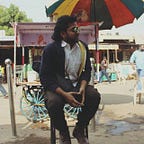The Father of Urdu Literature and Parrot of India (Tuti~e~Hind)— Amir Khusrow
When you hear the sound of Tabla and Sitar, the two instruments that clearly distinguish and characterise Indian music from others. Yes! you are hearing notes of Amir Khusrow’s masterpiece. In a country like India where each province has a different language and peculiar dialect of its own, a common and easy medium for communication was desperately needed to preserve unity. With this objective in view, he composed a large number of couplets and verses with mixed vocabularies of Turkic, Arabic, Persian and Braj Bhasha (a dialect closely related to Hindi) which laid foundations for the inception of a new language — Urdu. Over subsequent generations, the language was further developed and refined. It is now spoken by over four hundred million people in the world and is the official language of Pakistan.
Born in 651 AH/1253–4 AD in Patiyali in Uttar Pradesh, India and was named Abul Hasan Yaminuddin. His father, Amir Saifuddin Mahmud who, before coming to India, was the chief of a clan called “Lachin” in Turkistan during the rule of Changez Khan. After immigrating to India, he was assigned as a high official at the court of Sultan Shamsuddin Iltutmish. But this didn’t stopped him in learning languages of Indian subcontinent and later experiment with it. He was an intellectual giant of many languages, with knowledge of Turkish, Arabic, Persian and the vernaculars of northern India — the Khariboli, (Urdu and Hindi both being developed forms of it), Braj Bhasha and Awadhi. It was during his stay in Awadh, Delhi and Punjab that he learned these northern languages.
He also learned Sanskrit which he placed before all other languages, except Arabic, the language of his religion. Khusrow is also regarded as the “father of qawwali” (a devotional music form of the Sufis in the Indian subcontinent), and introduced the ghazal style of song into India, both of which still exist widely in India and Pakistan.
But according to him, his identity was different. He was a most dutiful and devoted mureed of Hazrat Nizamuddin Auliya, the fourth Spiritual Successor (Khalifa) of Hazrat Khwaja Moinuddin Chishti of Ajmer — the founder of the illustrious Order of Chishti saints in this country.
When he was eight years old, his father took him to Hazrat Nizamuddin Auliya. As his father was entering the door of the great Saint’s Khanqah, the young Hazrat Khusro audaciously said that it was up to him and not his father to choose his Pir. His father left him outside the door and went in alone to talk to the saint. In the meantime, Hazrat Amir Khusro composed a quatrain in Persian in order to test the spiritual capabilities of Hazrat Nizamuddin Auliya. Hazrat Amir Khusro affirmed to himself that he would only become a mureed of Hazrat Nizamuddin if a satisfactory answer was provided to the following quatrain:
“Toa aan shahey ke bur aiwaan-e-qasrat
Kabutar gar nashinad baaz gardad.
Gharib-e-mustamandey bur dar amad,
Beyayad androon yaa baaz gardad.”
Translation(English): You are that great a king that, if on the roof of your grand palace a pigeon were to sit, it becomes a skylark. A poor and humble soul has come to your door, should he enter or should he go away?
Hazrat Nizamuddin Auliya immediately replied and sent the following reply to Hazrat Amir Khusro in the same form as the initial quatrain:
“Beyayad androon mard-e-haqiqat
Ke baa maa yak nafas hamraz gardad.
Agar ablay buwad aan mard-e-naadaan,
Azaan raahey ke aamad baaz gardad.”
Translation(English): Do come in, oh truthful soul, so that we may become close and become trusted friends. But if you are ignorant and have no wisdom, then you better go back the way you came.
When Hazrat Khusro heard the quatrain, which to him was a perfect reply, he entered the room and became a mureed of Hazrat Nizamuddin Auliya — faithfully serving his master throughout his life. There are various popular stories of his devotion and love for his master.
Hazrat Amir Khusro has authored over 90 books. His famous book entitled Rahat-ul-Mohibbeen encompasses the discourses of Hazrat Nizamuddin Auliya. But he is Known and popular for his “pahelis” and “Dohas”, which form part of Indian folklore. I have selected some of the best of them. Read and take a essence of your childhood, you might have heard them when you were small:
Doha’s
आ साजन मोरे नयनन में, सो पलक ढाप तोहे दूँ।
न मैं देखूँ और न को, न तोहे देखन दूँ।।
उज्जवल बरन अधीन तन एक चित्त दो ध्यान।
देखत में तो साधु है पर निपट पाप की खान।।
खुसरो दरिया प्रेम का, उल्टी वा की धार।
जो उतरा सो डूब गया, जो डूबा सो पार।।
खुसरो पाती प्रेम की बिरला बाँचे कोय।
वेद, कुरान, पोथी पढ़े, प्रेम बिना का होय।।
Paheli’s
बीसों का सर काट लिया
ना मारा ना ख़ून किया
(उत्तर=नाखून)
एक नार ने अचरज किया। साँप मार पिंजरे में दिया
ज्यों-ज्यों साँप ताल को खाए। सूखै ताल साँप मरि जाए
(उत्तर=दिये की बत्ती)
खड़ा भी लोटा पड़ा पड़ा भी लोटा।
है बैठा और कहे हैं लोटा।
खुसरो कहे समझ का टोटा॥
(उत्तर=लोटा)
एक गुनी ने यह गुन कीना, हरियल पिंजरे में दे दीना।
देखा जादूगर का हाल, डाले हरा निकाले लाल।
(उत्तर=पान)
श्याम बरन और दाँत अनेक, लचकत जैसे नारी।
दोनों हाथ से खुसरो खींचे और कहे तू आ री।।
(उत्तर=आरी)
I preserved the best one for the end and i will not tell it’s answer. You need to submit your guesses in comments:
आगे-आगे बहिना आई, पीछे-पीछे भइया।
दाँत निकाले बाबा आए, बुरका ओढ़े मइया।।
